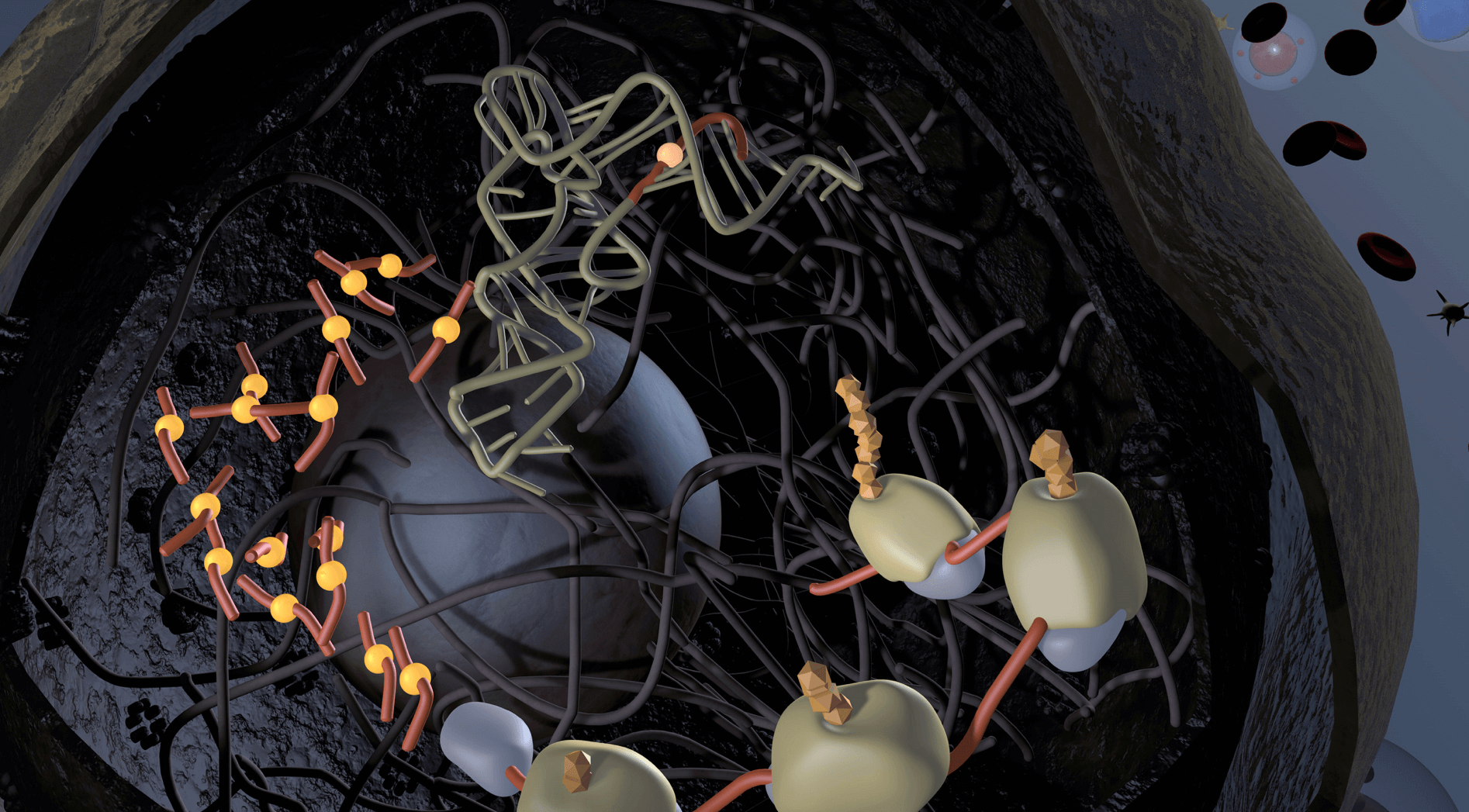Bellodi Group
Our goal is to uncover how the RNA modifications rewire genetic information, shaping normal and malignant hematopoiesis. By addressing fundamental questions in RNA and cancer biology, we aim to translate our discoveries into innovative therapeutic strategies.
We are looking for talented students and postdocs to join our team. Please contact Cristian.Bellodi@BRIC.ku.dk.

My laboratory explores how conserved RNA modifications, noncoding RNAs, and RNA-binding proteins regulate gene expression during development and tumorigenesis. Focusing on the RNA epitranscriptome, we investigate its role in shaping molecular and cellular processes critical to stem cell and cancer biology. Using the immune system as a model, we combine advanced genetics, sequencing, and biochemistry to uncover uncharted epitranscriptomic pathways driving normal and malignant hematopoiesis, aiming to translate these findings into groundbreaking RNA-based cancer therapies.
The mechanisms directing genetic information at the post-transcriptional level during development and tumorigenesis remain largely unresolved. We are intrigued by evidence that RNA modifications, noncoding RNAs, and RNA-binding proteins create new regulatory layers that shape gene expression across spatial and temporal dimensions.
Our research focuses on unveiling how the RNA epitranscriptomic machinery directs essential molecular and cellular processes, addressing fundamental questions in stem cell and cancer biology. Using the immune system as our lens, we integrate cutting-edge genetic tools, advanced sequencing technologies, and biochemical approaches, to illuminate epitranscriptomic pathways that define cell identity and function during normal and malignant hematopoiesis. Our ultimate goal is to translate these discoveries into innovative RNA-based therapeutic strategies for hematological and solid cancers.
RNA pseudouridylation in stem and cancer cells
RNA pseudouridylation (Ψ) is a widespread RNA modification that rapidly rewires genetic information within cells and tissues upon stress conditions. Pioneer work from my lab revealed a pivotal Ψ-driven epitranscriptomic program that steers protein synthesis, growth, and differentiation potential of human embryonic and hematopoietic stem cells (HSCs) (Guzzi et al., Cell 2018, Guzzi et al., Nature Cell Biology 2022). Our study uncovered that Ψ ‘writer’ PUS7 epitranscriptomically controls a novel class of stem cell-enriched tRNA-derived small RNAs (tdRs), mTOGs, providing spatiotemporal control of protein synthesis during embryonic and hematopoietic development (Muthukumar et al., Nature Reviews Molecular Cell Biology 2024).
Translation control of RNA splicing in cancer
Dysregulation of splicing is a central hallmark of human cancers; however, the underlying mechanisms by which oncogenes co-opt the splicing machinery (spliceosome) to promote malignant transformation remain poorly understood. We recently revealed the oncogenic translation landscape that critically remodeled central spliceosome nodes to enable cancer-promoting alternative splicing patterns during malignant transformation (Cieśla et al., Molecular Cell 2021; Cieśla et al., Molecular Cell 2023). By extension, we defined an RNA-driven mechanism that control the melanoma oncogene MITF, mediated by the RNA helicase and splice factor DDX3X. This molecular mechanism underlies a proliferative-to-invasive phenotype switch associated with metastatic dissemination and therapy resistance in vivo (Cieśla et al., Cell Reports 2019).
Regulation of gene expression by small noncoding RNAs
Small nucleolar RNAs (snoRNAs) are abundant and evolutionarily conserved noncoding (nc) involved in site-specific nucleotide modifications of regulatory RNAs such as spliceosomal (snRNA) and ribosomal RNA (rRNA). While snoRNA dysregulation is common in cancer, how these small RNAs contribute to tumorigenesis remain poorly characterized. Our work highlighted how perturbations of snoRNA subsets impact ribosome function in hematopoiesis and cancer (Bellodi et al. EMBO 2010, Jack et al. Mol Cell 2011, Bellodi et al. Cell Reports 2013). More recently we uncovered a critical role for a small Cajal body-specific RNA (scaRNA15) in orchestrating alternative splicing (AS) associated with major oncogenic hallmarks (Beneventi et al., NAR Cancer 2021).
RNA, one of life’s essential molecules, drives the flow of genetic information within cells. Our research aims at uncovering post-transcriptional gene regulatory pathways driven by RNA modifications that define cell fate in health and disease at the molecular, cellular and organismal level.
Delineate the RNA pseudouridine epitranscriptome in normal and malignant hematopoiesis.
Building on our work illuminating an essential role for pseudouridine in hematopoiesis, we combine a genetic models and cutting-edge sequencing approached to study how RNA pseudouridylation steers the translatome, impacting hematopoietic cell identity and fueling leukemogenesis.
Study inflammation through the RNA epitranscriptomic lens. Research by us and others has uncovered unanticipated roles for RNA-modifying proteins (RMPs) in adapting to cellular stress responses. Specifically, we explore how the epitranscriptome influences inflammation and genome stability in vivo, with implications for common autoimmune conditions and cancer.
Determine the oncogenic translatome driving spliceosome composition. Our published work indicates that translation is a critical nexus that governs distinct splicing factor networks upon oncogenic stress. We combine bioinformatics, state-of-the-art molecular probing and gene editing strategies to reveal the principles reprogramming spliceosome function in cancer.
Unravel small RNAs driven epitranscriptomic control at the interface of early development and disease. How epitranscriptomic programs govern by small RNA control genetic information is vastly unknown. We perform integrative analysis to inform about functional links between RNA modifications and small RNAs in regulation of cellular metabolism in development and across different cancers.
Our research seeks to characterize the post-transcriptional facets of gene expression that shape normal and cancer cell fate at molecular, cellular, and organismal levels. We use hematopoiesis as our main model system to investigate how RNA modifications influence the proteome of stem and cancer cells. Specifically, we leverage advanced biochemistry, flow cytometry, proteomics, and sequencing techniques alongside mouse genetic engineering and genome editing. These approaches enable us to map epitranscriptomic, translational, and splicing programs in normal and malignant hematopoiesis.
Cieśla M, Ngoc P, Muthukumar S, Todisco G, Madej M, Fritz H, Dimitriou M, Incarnato D, Hellström-Lindberg E, and Bellodi C. m6A-driven SF3B1 translation control steers splicing to direct genome integrity and leukemogenesis. Molecular Cell 2023, Apr 6;83(7):1165-1179.e11. Epub 2023 Mar 20. PMID: 36944332. Read it through this link.
Guzzi N, Muthukumar S, Cieśla M, Todisco G, Ngoc PCT, Madej M, Munita M, Fazio S, Ekström S, Mortera Blanco T, Jansson M, Nannya Y, Cazzola M, Ogawa S, Malcovati L, Hellström-Lindberg E, Dimitriou M and Bellodi C. Pseudouridine-modified tRNA fragments repress aberrant protein synthesis and predict leukaemic progression in myelodysplastic syndrome. Nature Cell Biology 2022, Mar;24(3):299-306. PMID: 29628141. Read it through this link.
Beneventi G, Munita R, Ngoc PTC, Magdalena Madej, Cieśla M, Muthukumar S, Krogh N, Nielsen H, Swaminathan V, Bellodi C. The small Cajal body-specific RNA 15 (SCARNA15) directs p53 and redox homeostasis via selective splicing in cancer cells. NAR Cancer 2021 Jul 9;3(3):zcab026. PMID: 34316713. Read it through this link.
Cieśla M, Ngoc PCT, Cordero E, Martinez ÁS, Morsing M, Muthukumar S, Beneventi G, Madej M, Munita R, Jönsson T, Lövgren K, Ebbesson A, Nodin B, Hedenfalk I, Jirström K, Vallon-Christersson J, Honeth G, Staaf J, Incarnato D, Pietras K, Bosch A, Bellodi C#. Oncogenic translation directs spliceosome dynamics revealing an integral role for SF3A3 in breast cancer. Molecular Cell 2021 Apr 1;81(7):1453-1468.e12. PMID: 33662273. Read it through this link.
Cieśla M, Phung B, Sanna A, Guzzi N, Beneventi G, Ngoc PTC, Martin Lauss M, Rita Cabrita R, Eugenia Cordero E, Bosch A, Rosengren F, Häkkinen J, Klaus Griewank K, Paschen A, Harbst K, Olsson H, Ingvar C, Carneiro A, Tsao H, Schadendorf D, Pietras K, Jönsson G and Bellodi C The X-linked DDX3X RNA helicase dictates translation re-programming and metastasis in melanoma. Cell Reports 2019 Jun 18;27(12):3573-3586e7. PMID: 31216476. Read it through this link.
Guzzi N, Cieśla M, Ngoc PCT, Lang S, Arora S, Dimitriou M, Pimková K, Sommarin MNE, Munita R, Lubas M, Lim Y, Okuyama K, Soneji S, Karlsson G, Hansson J, Jönsson G, Lund AH, Sigvardsson M, Hellström-Lindberg E, Hsieh AC, Bellodi C. Pseudouridylation of tRNA-Derived Fragments Steers Translational Control in Stem Cells. Cell 2018 May 17;173(5):1204-1216.e26. PMID: 29628141. Read it through this link.
Bellodi Group
- Professor Andrew Hsieh Fred Hutch Cancer Research Center, USA
- Professor Paolo Salomoni, DNZE, Bonn, DE
- Professor Eva Hellström-Lindberg, Karolinska Institutet, SE
- Dr Ana Bosch Campos, Lund University Hospital, SE
- Professor David Bryder, Lund University, SE
- Associate Prof. Joan Yuan, Lund University, SE
- Associate Prof. Vinay Swaminathan, Lund University, SE
- Professor Göran Jönsson, Lund University, SE
- Dr Danny Incarnato, University of Groningen, NL
- Professor Mikael Sigvardsson, Linköping Univeristy, SE
- Associate Professor Anders Wittrup, Lund University, SE
- Dr Francesco Nicassio, Italian Institute of Technology, IT


